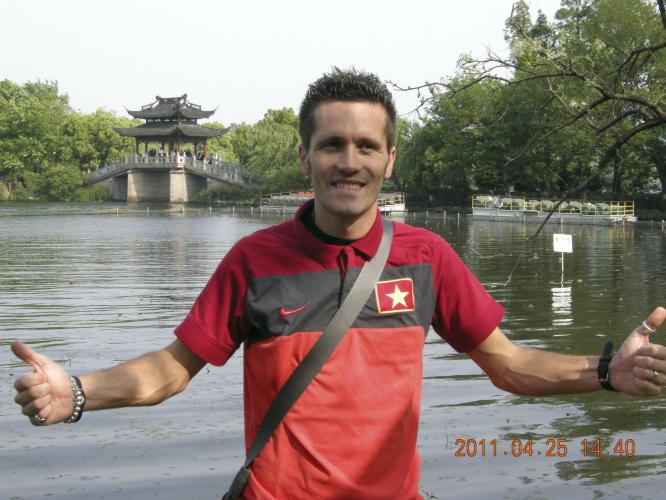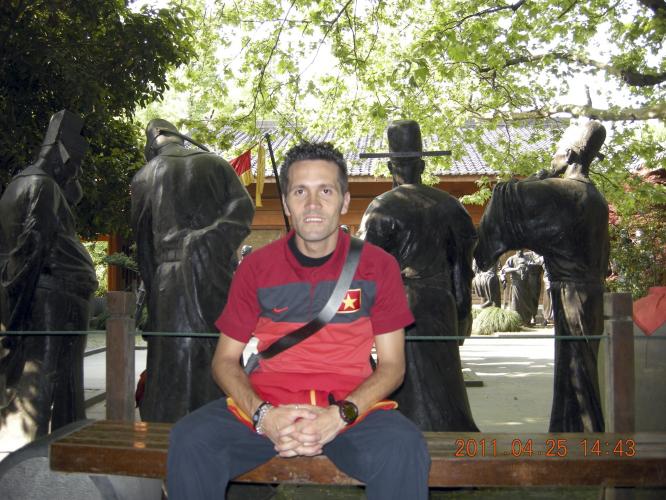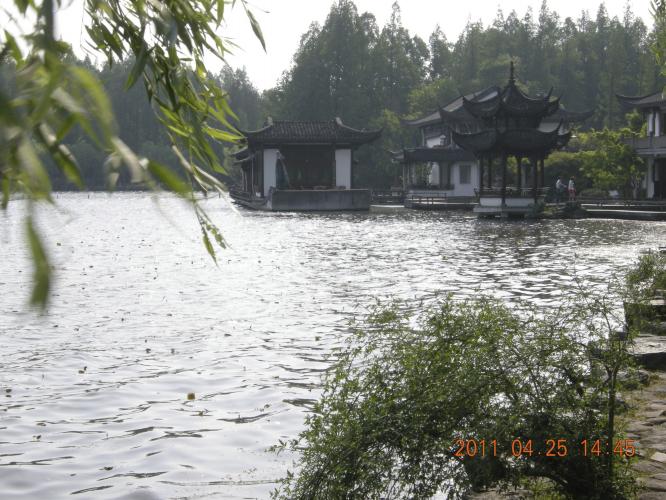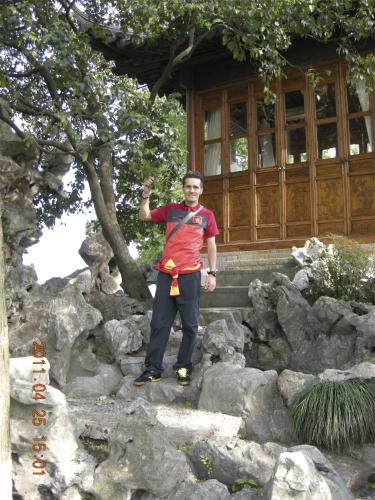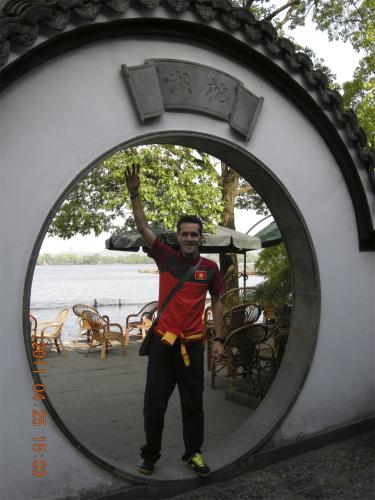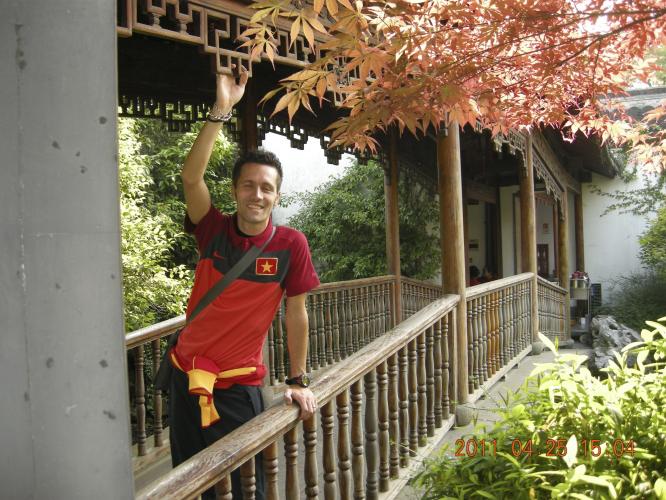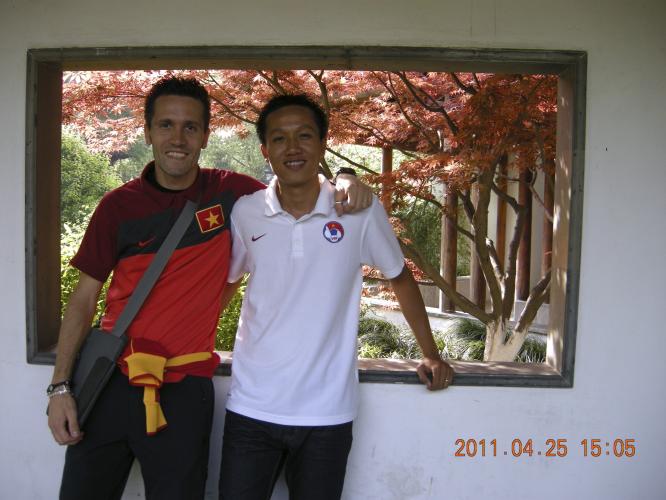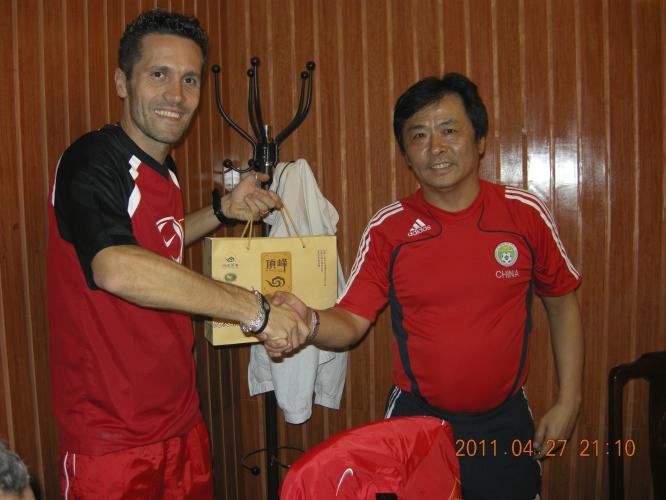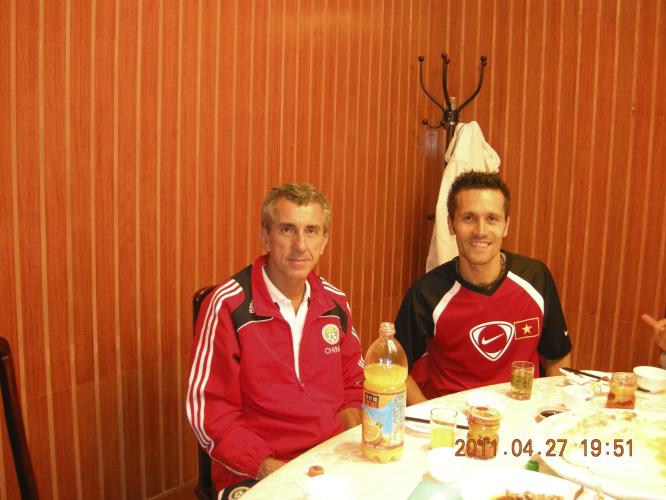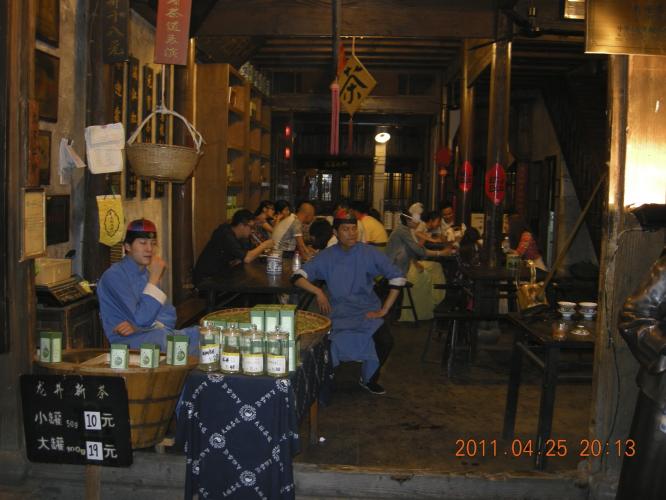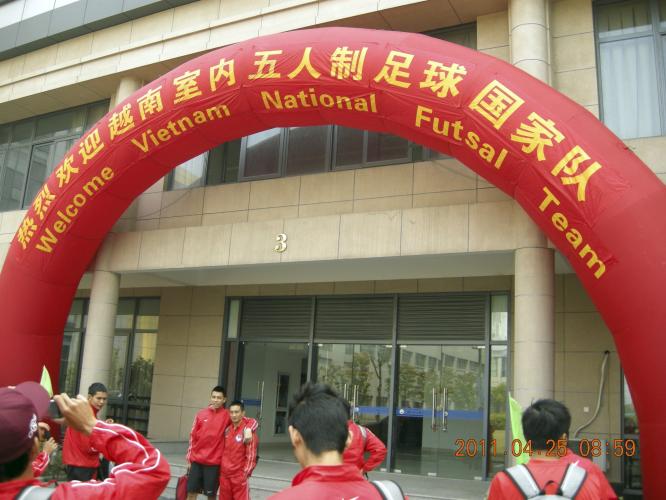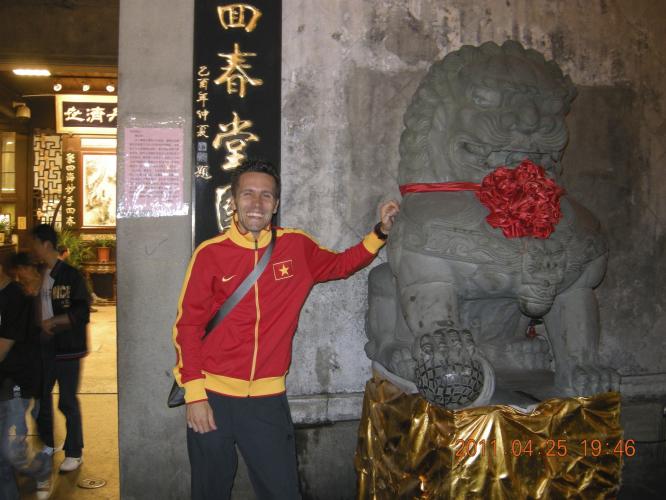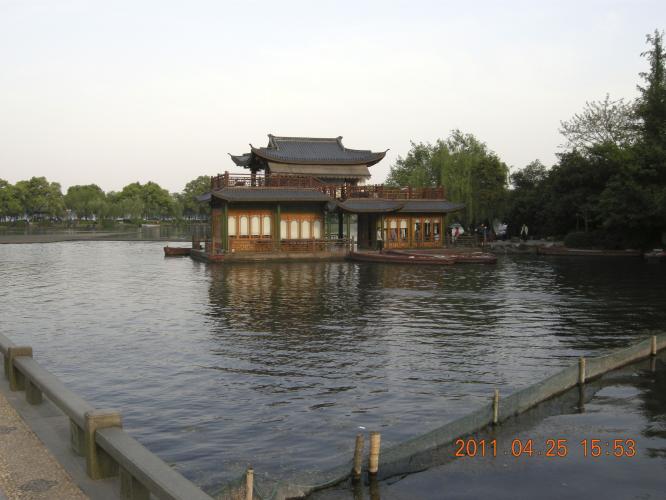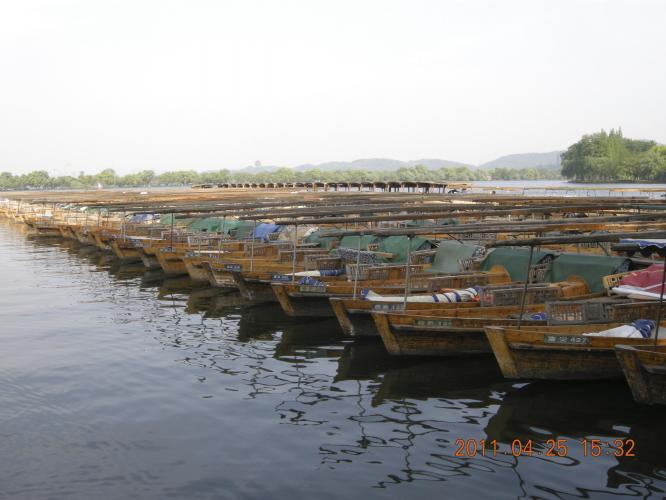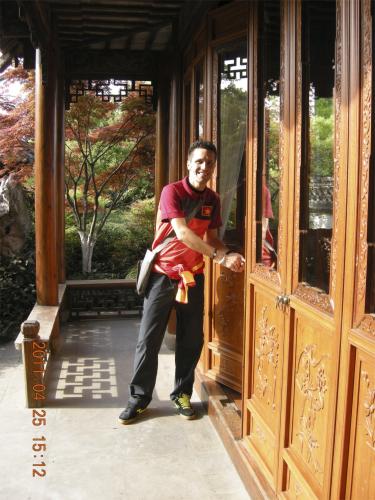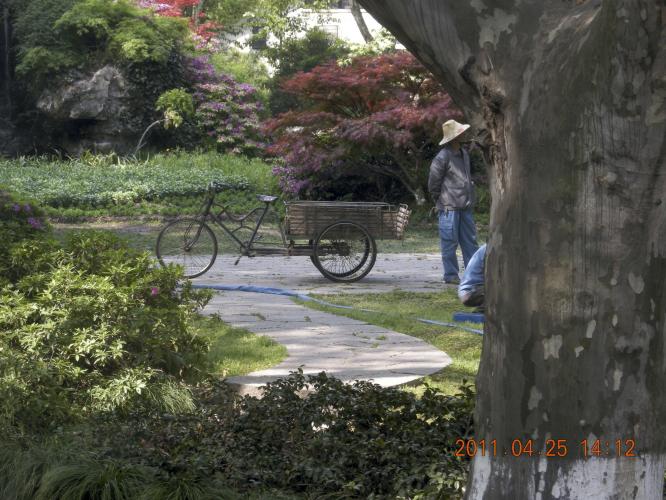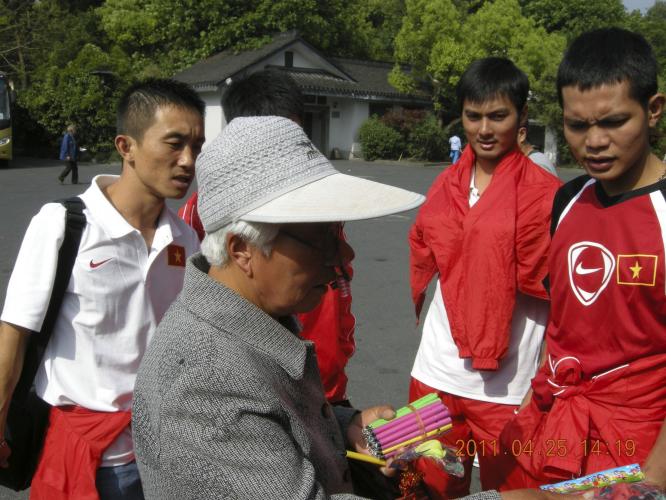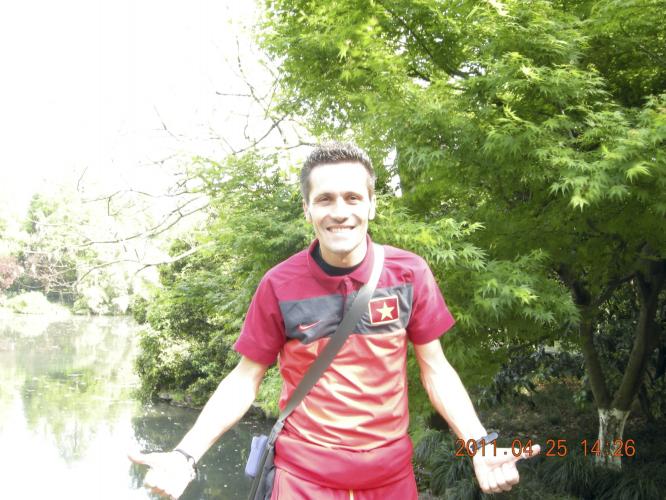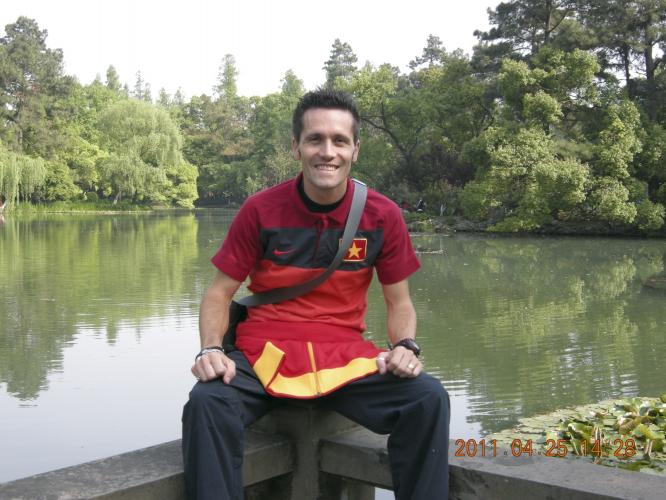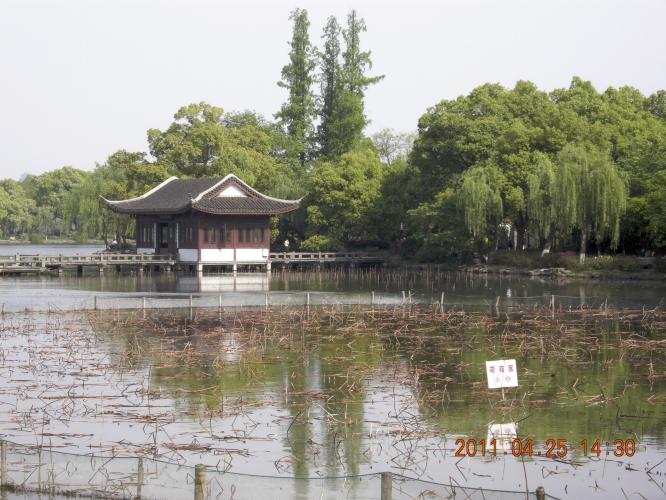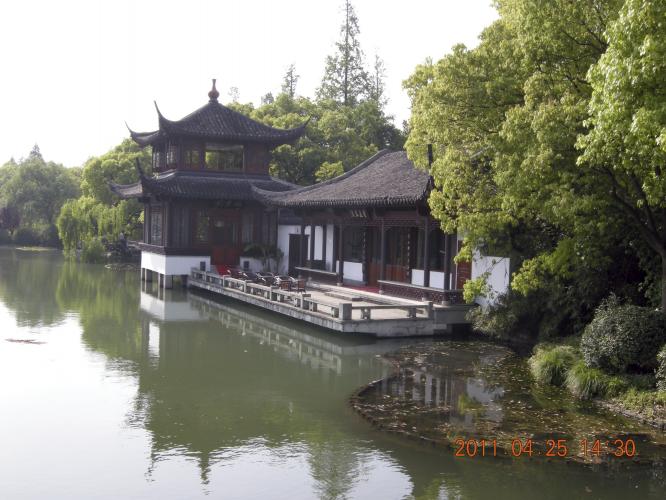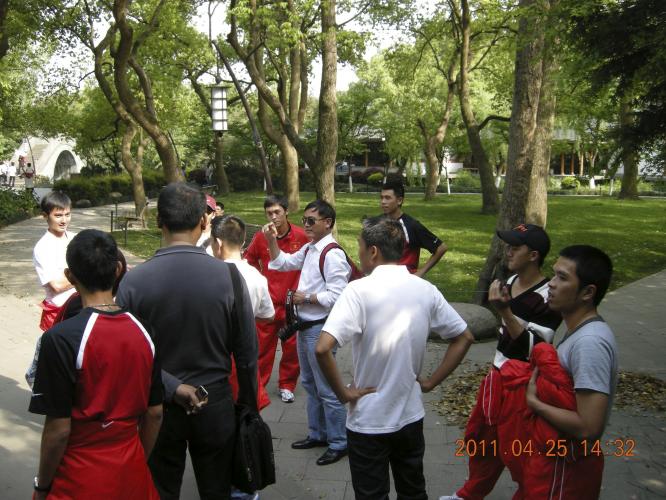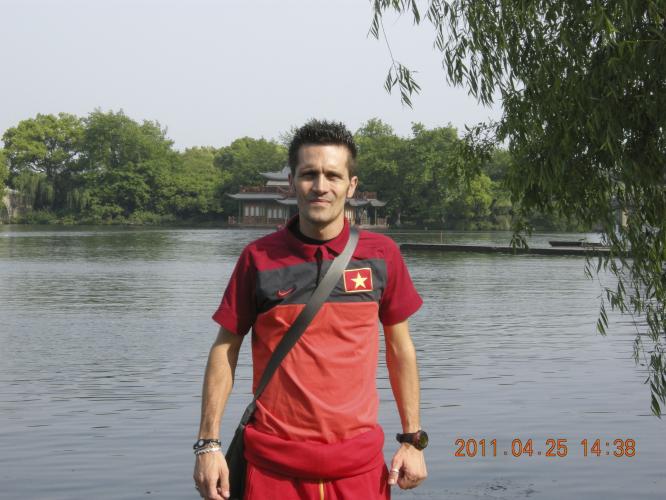HANGZHOU APRIL 2011
Hangzhou is in Zhejiang Province, China. It is one of the most important tourist cities in China, famous for its natural beauty and historical and cultural heritages.
Famed for its natural scenery, Hangzhou and its West Lake have been immortalized by countless poets and artists. The city was the capital of the Southern Song Dynasty from 1127 until the Mongol invasion of 1276, during that time the city's population is estimated to have been as high as one million, making it the largest city in the world at the time. Even Marco Polo claimed to have passed through, calling it 'beyond dispute the finest and the noblest in the world'.
With the gradual silting up of its harbor, much of the city's trade and industry passed north to nearby Shanghai, but the city still has a bustling population of 1.7 million and ranks as one of China's most popular tourist attractions.
Hangzhou's most famous scenic sight. Technically, there are 10 Scenes of the West Lake and 10 New Scenes, but they are overrated, and often seasonal (Snowfall Over Broken Bridge, etc). Rather than make a checklist and walking back and forth looking for them, simply spend a clear day wandering the circumference of the lake and the causeways, take a ferry to the islands, and you will probably cover most of the sites anyway. The 'West Lake' itself can be divided into countless smaller sites, from Mr. Guo's villa to 'Orioles Singing in the Willows'.
The 'West Lake Scenic Area' itself is very large. This section only covers areas in the immediate vicinity of the lake. Other spots are covered in later sections.
Boat Ride. There are numerous providers of boat rides on the lake. The official tour operator sells tickets from official ticket stalls for boat trips covered by insurance, with clear pricing and which covers all parts of the lake. There are lots of private gondola rides with varying insurance coverage, range and prices.
Sitting on a bench, overlooking West Lake
Lesser Yingzhou Isle (Three Pools Mirroring the Moon)— Built in the early 1600s, this is the largest island on the lake. When there is a full moon, candles inside the pagodas are lit, and in the candle light it appears as though you see the moonlight (if you are romantic enough to see it), hence the name.
Mid-Lake Pavilion— Bulit in 1552, it is the oldest island in Hangzhou. There is a Chinese inscription on the Qing Dynasty-era stone arch in which the Qing Emperor wrote 'Chong Er', or 'Endless Love'.
Lord Ruan's Mound— This is a mound they made from piling up dirt after dredging the lake 200 years ago. However, it is not just a dirt mound. At night (summer), entertainment activities are occuring in the garden on the island.
Hubin #X Park— Hubin Parks 1, 3, 6 and probably the numbers in between are the parks between Hubin Road and the West Lake. Relatively newly-designed as the West Lake Tunnel that goes underneath was being built in early 2004, these parks are good to sit for a bit, buy ice cream or a newspaper, and most importantly hire a boat from the cluster of boat docks at each park.
Su Causeway— Almost 3km long, this causeway dates from the year 1189 and has a bunch of willows and peach trees. It is long north-south causeway that starts by the Shangri-La on Beishan Road and goes all the way down to Nanshan Road.
Bai Causeway— Starting at the eastern end of Beishan Road, this cause way leads to Solitary Hill and cuts off the distances between, say, Hubin Road and the Shangri La.
Solidary Hill And Zhongshan Park— Where Loud Wai Lou restaurant is located, this is the only natural island on the lake. At least 3 emperors constructed palaces are here. Besides an expensive restaurant, the popular area is the home of the Xiling Seal-Engravers' Society, and the seals, calligraphy, engraving-masters, and relics that go along with it.
Yang Causeway— This is more than 3km long and one road west of the Su Causeway. It starts at the intersection of Beishan and Shuguang Road (which becomes Yang Causeway once you are south of this intersection); the causeway runs north-south. Yang Causeway includes Quyuan Garden (aka Qu Garden aka Qu Courtyard), which is the most popular spot to see tons of lotus blossoms (late spring > summer). The water area to the west of the top of Yang Causeway is Maojiabu Scenic area, with orchids blended into the water scenery. Another tourist spot on Yang Causeway is Mr. Guo's Villa, which was built in 1907 and is considered one of the most 'classical' gardens in Hangzhou. At the southern end of the causeway, just before Nanshan Road, is a fish-viewing pond.
King Qian's Memorial, (Qian Wang Ci)— 5 kings of the Wuyue Kingdom are buried here in this memorial on the south end of the lake off Nanshan Road.
Wushan Square, (吴山广场 Wu Shan Guang Chang)— Wushan Square and Wushan Hill are a major town center in Hangzhou. The view from the top is excellent on a clear day, and there are also trails around the hills from behind the pagoda. The pagoda itself has been modernized with an elevator and nice open-air teahouse at the top, but the original bell is still intact and in use. This area also features easy access to Hefang Jie shopping street at the base of the hill, full of small pedestrian streets and shopping stalls. It is also extremely close to the West Lake itself.
[edit]Temples, pagodas and churches
Six Harmonies Pagoda, (六和塔 Liùhé Tǎ)— Down by the Qiantang River, about a 15 minute cab ride from the lake in light traffic, but it is a pretty road to drive down through all the tunnels and tea fields. Besides the pagoda itself, which is arguably the most prominent of all the temples and pagodas in Hangzhou, there is an adjacent park with hundreds of realistic replicas of the world's most famous pagodas, complete with mini-sized trees in front of the pagoda models.
Lingyin Temple, (灵隐寺 Língyǐn Sì)— Meaning 'heart of the soul's retreat', this temple west of the West Lake is an active Buddhist temple at the bottom of a hill. Nearby you can take a chairlift to the top of the hill where there is another temple (walking up is also an easy set of stairs below the chairlift). This is one of the 3 oldest and most famous temples in China. There are hundreds of Buddhist stone statues carved into the cliffs in the 'Peak Flying from Afar' section next door.
Leifeng Pagoda (雷峰塔)— Located on the shores of the southeast side of the lake and originally built in the year 977, all that remains of the original pagoda is the crumbling foundation, viewable from outside the glass case that it is housed in (Pagoda Remains Memorial Museum at the bottom floor of the pagoda). With escalators, elevators, and a totally new pagoda places on top of the foundation, there is not much to see within the pagoda itself; it was most recently rebuilt in 2000. However, the view of the city skyline is one of the best from here, and some of the smaller seating areas around the perimeter of the pagoda have a nice breeze and view of the structure. One of the 10 Scenes of the West Lake is 'Leifeng Pagoda in Evening Glow', but this is best viewed from a distance (across the lake) just after sunset. Keep in mind that the entry fee for the Leifeng Pagoda is very expensive (¥40/person, Oct 2008) and it's not original, just rebuilt, so if your budget is not that huge, consider to not enter the Pagoda. You can still take pictures in front of it.
Baochu Pagoda, (保俶塔 Bǎochù Tǎ) and the surrounding temples on this hill on the north side of the lake. You cannot climb the pagoda, but the view and surrounding Baoshi Hill are awesome.
Jingci Temple— Off Nanshan Road, built in 954, the Jingci Temple has a huge 10-ton bell inside. Located on Nanping Road, they ring the bell 108 times here to ring in Chinese New Year. It is also rung every evening for much fewer times. Jingci Temple is the site of the legend of the miraculous well, which can be seen on the grounds of the temple.
Jade Emperor Hill, (玉皇山公园 Yuhuang Shan Gong Yuan)— One of the least-visited sites in Hangzhou despite its somewhat central location. The main temple on top of the hill is currently under reconstruction (Aug 2008), but still offers a wonderful view of the city and lake below, and has a restaurant next door. There is another temple partway up the hill. The area can provide a quiet escape and a nice hike, as well as the chance to visit one of the few Daoist sites in the area (most other local temples are Buddhist). It is located directly south of Leifeng Pagoda. The main entrance isn't far from the Silk Museum. If you are playing along with the '10 Scenes of the West Lake' scavenger hunt still, the one that applies to the top of this hill is 'clouds flying over Jade Emperor Hill'.
Chongyi Church, (崇一堂 Chóngyī táng) is one of the largest Protestant churches in China. The name, translated into English, means 'Worship the one and only true God.' It was dedicated in 2005 and can accomodate up to 7000 attenders, welcoming many international visitors and guest preachers including Franklin Graham, the son of evangelist Billy Graham.
[edit]Gardens, forests, nature
Longjing (Dragon Well) Tea Fields, (龙井茶园 Long Jing Cha Yuan), and other tea fields further west. These are best visited during the harvest period, usually from the first week of March till after May Holiday, when everyone is out in the field picking tea and the tea that you can purchase is of the best quality (tea crops from later in the year have had their leaves damaged by the rain).
Guo's Villa, (郭庄 Guo Zhuang [6]), is the best existing traditional private garden in Hangzhou. It is one of the garden masterpieces of Jiangnan (the lower region of the Yangtze River) thanks to its incomparable surroundings and the smartly managed garden space. The garden develops as you enter further into it with regular switches between tight, closed spaces and sudden, open ones. The key feature, or spirit, is water. Cleaverly juxtaposing shade and light, curved and straight, yin and yang, the garden of Guo Zhuang is a wonderful embodiment of the Chinese wisdom of Tao and the Way of Nature. The teahouse, Liang Yi Xuan (两宜轩 Belvedere of Both Good) sits in a prime viewing spot within the garden between two superb water 'yards', one large and the other small. While there are plenty of 'old villas' in China to visit-- and many are similar-- this one is also on the shore of the West Lake. The 10 yuan entry fee keeps many people away, and you can have some tea (40 yuan) on the lakeside pavilions of the villa while avoiding the tourists.
Hangzhou Botanical Gardens, (植物园 Zhi Wu Yuan), and flower nursery as well nearby. If you can't make it to Suzhou, these gardens aren't bad, especially in the spring and during the brief period when the leaves change in the fall. There is also a peacock farm, some nice ponds, and basically a wide range of plants and ecosystems to walk through. The redwood tree that Nixon donated during his visit has since died (in 2001).
Xixi National Wetlands Park. Opened in May 2005, this wetlands park is in the extreme west part of the city past the west bus station. One of the easiest ways to get there would be to take a bus from Huanglong Soccer Stadium. While it may be somewhat out of the way and the road signs have the English translation as an uninviting 'Xixi Swamp', this area is not to be missed, as currently the tourists are not too many, and it is a great way to see birds and other wildlife. The birds are especially beautiful and varied.
Dreaming of the Tiger Spring, (虎跑梦泉 Hǔpǎomèngquán), is a spring as well as a scenic and historic destination. The area includes wooded pathways, streams, bamboo groves, tea houses, historic structures, as well as the spring itself and other sights. Admission is ¥15. Tea brewed with the high-quality Tiger Spring water may be purchased for about ¥20 a glass.
Impression West Lake (印象西湖) [7]. Directed by the internationally-acclaimed Zhang Yimou, a love story performed with impressive special effects on the lake. There are two performances every night, and it is a spectacle not to be missed.
Early morning bikeride. Start on the north side of the lake, and head west towards Zhejiang University, then down Lingyin Road past the Botanical Gardens and into Longjing Village. Keep heading West and south through the tea villages, bamboo forest, and scenic valleys to the river and cut over towards Six Harmonies Pagoda. Go back to the south end of the lake via the road right next to Six Harmonies, past the zoo, through the tunnels. Cycling is banned directly alongside the lake for about half of the way, so walking may be better if you want to see the lake.
Walk around the lake. It will take you about 5 hours of slow walking. The lake is not very big and there are two shortcuts (causeways) through it. You can also hire small non-motor powered boats (¥120/hour for personal boat with driver, or use the ferry services) to take you around the lake and to the two islands, which feature some interesting sites.
Go Hiking in the Mountains. Truly Hangzhou has the most accessible and interesting hiking environments within walking distance of any city. Purchase a topographic map, not difficult to find. Suggestion 1. Start with the the climb up to the Baochu Pagoda from Beishan Road, the trail passes the pagoda and continues on with a rock scramble and great views to a series of stone paths that follow the ridge. Keep going and relax, you can't get lost because this mountain is surrounded by main roads. There are temples, shrines and caves along the way with a sprinkling of tea houses. Stay with the high ground where you can and you should come out near the corner of Shuguang Rd and Beishan Rd. in an easy 2 hours, with plenty of opportunities for side explorations. You can walk back or return by bus (be brave, as long as the bus is going inbound it will take you somewhere central. The fare will be Y1-3 and services are frequent) or cab. Suggestion 2. Start at Wushan Square, at the southern end of Yan'an Rd, and walk south through the developed park land. Stay high, and pass the war memorial, stunning stone sculptures, down the large stairway to Wansongling Rd. Cross the road, turn left and 100 metres later enter the forest past a memorial garden. From here the stone paths lead inexorably south to Fenghuang Hill and then south west finally to Yuhuang Hill, the summit of which contains a large temple complex and boasts marvellous views over West lake and the Qiantang River. Descend to the west, but beware the tricky circular road, to Hupao Road and take a bus back from the Hangzhou zoo bus stop. It will take a slow 4 hours. You will at times be geographically challenged, but soon you will get the drift of it, and be better prepared to tackle the huge mountain, forest and tea village areas to the south west of the lake. The complete circuit from Xixi Rd to Wushan Square via Northern Peak, Shi Peak, Wuyun Hill, Jiuxi, HZ Zoo, Yuhuang, Fenghuang Hill will take a party of regular fitness, with stops, 10-12 hours. Then for a hike with a difference, hike out to Meijiawu and stay at a guest house, returning the following day via a different route.
Visit the temples and pagodas. The most popular ones are Baochu pagoda, which is the tower-like one on a hill on the north side of the lake. This hill is a great hike, with excellent views of the lake and city, several smaller temples of a variety of religions, and Huanglong Cave on the northern slope of the hill. 6 Harmonies Pagoda, located on the river, is the largest and most imposing. A fun hike after the pagoda leads from the shores of the river, behind the pagoda, and into the Longjing tea fields near the tea museum.
Spend an afternoon at a tea house. A highlight of visiting Hangzhou is getting out to Manjuelong Village, (South of the lake on top of the hill) Longjin Village or Meijiawu Village, (west and further west of the Lake, respectively) to drink your tea. These villages have had a make-over in the last 2 or 3 years and while can be busy at weekends they are still great places to while away an afternoon watching the tea being picked. The tea houses all serve very local food - pickled vegetables, chicken broth etc - but often there is no menu; rather the owner will suggest what you should eat. Make sure you get a price for the dishes before you tuck in.
Hangzhou China Silk Town on Tiyuchang Road. You can also get silk at other places in the city, but most of it will just be the fabric. It is open from 8am to 5pm and is near the Zhejiang International Hotel. Bargain hard!
Night Market off Yan'an Road near Pinghai Road (right near Wushan) every night. Here you can find Mao memorabilia, jewelery, paper fans, pipes, luggage, handicrafts and other items that most Chinese cities have. Pirated DVDs and counterfeit handbags are for sale as well. You can also find a lot of those silk-screen printed paintings/embroidery things that the silk market also has. Bargain very hard - Many stalls sell the same stuff, so be prepared to walk away. Be careful buying 'antiques' because they are probably new, and pearls. Often the pearl culturing process has been very short, and in fact the 'pearl' is a plastic marble with only the thinnest of cultured skin.
Tea - Dragon Well/Longjing tea is famous throughout China and worth getting if you like green tea. If you are staying with a Chinese host somewhere else in China after Hangzhou, bringing them a small box (or two) of higher-end Longjing Tea would make a great gift; however, bear in mind that these usually cost around ¥300/box (more at tourist stands). The Longjing village and tea fields area of Hangzhou (southwest of West Lake) are where Longjing tea is grown. Besides being worth a visit for the scenic sights alone, tea can be purchased here as well - fresh from the harvesters' bags if so desired. Many places across the city also sell tea, such as informal vendors and small shops easily identifiable by the boxes displayed inside or store names such as '西湖龙井茶' (West Lake Dragon Well Tea), as well as grocery stores and supermarket chains. Because of the fame of Longjing tea, fake and low-grade varieties exist. If you have no experience buying tea, purchase from a reputable-looking establishment or ask the advise of a knowledgeable native.
